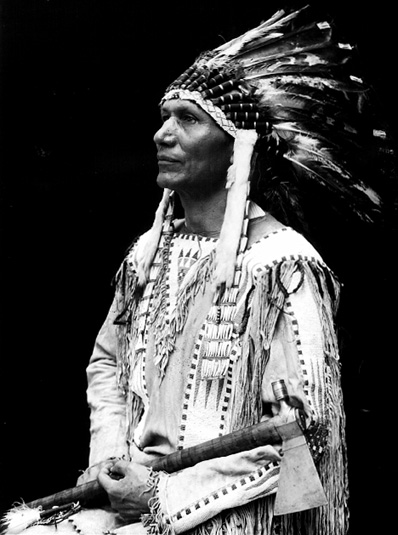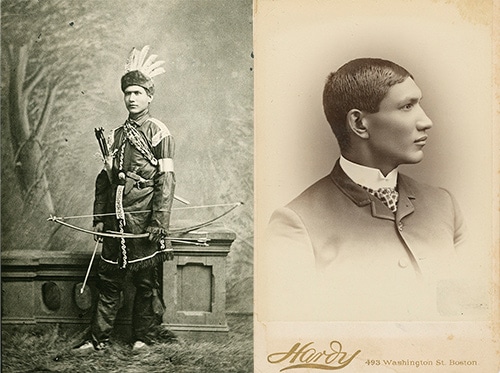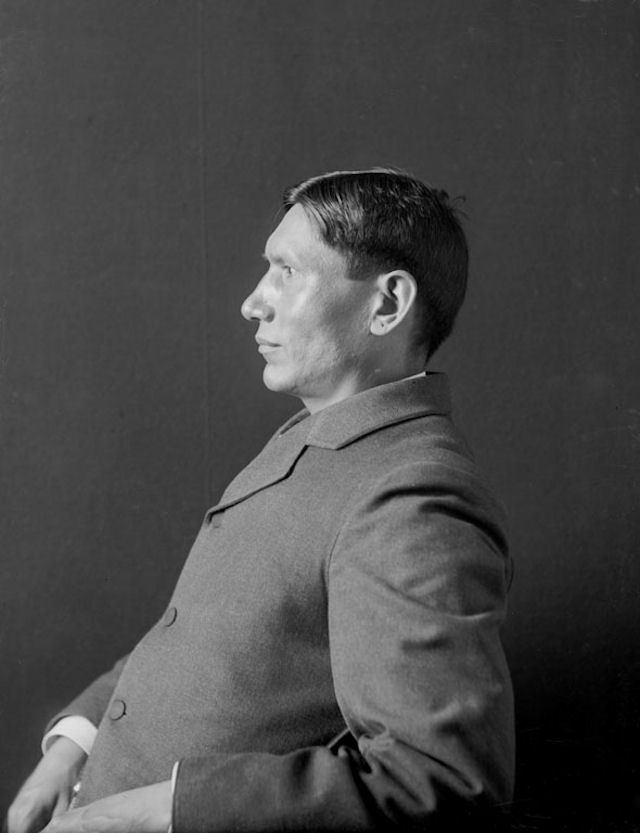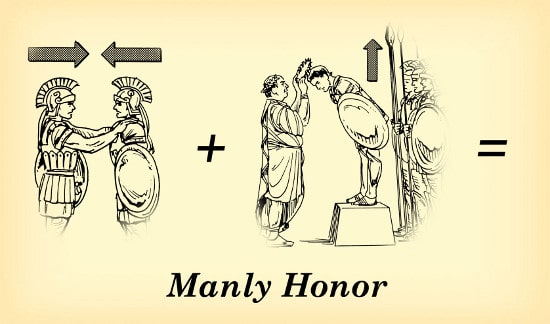With our archives now 3,500+ articles deep, we’ve decided to republish a classic piece each Friday to help our newer readers discover some of the best, evergreen gems from the past. This article was originally published in September 2015.
The Indian, in his simple philosophy, was careful to avoid a centralized population, wherein lies civilization’s devil. He would not be forced to accept materialism as the basic principle of his life, but preferred to reduce existence to its simplest terms. His roving out-of-door life was more precarious, no doubt, than life reduced to a system, a mechanical routine; yet in his view it was and is infinitely happier. To be sure, this philosophy of his had its disadvantages and obvious defects, yet it was reasonably consistent with itself, which is more than can be said for our modern civilization. He knew that virtue is essential to the maintenance of physical excellence, and that strength, in the sense of endurance and vitality, underlies all genuine beauty. He was as a rule prepared to volunteer his services at any time in behalf of his fellows, at any cost of inconvenience and real hardship, and thus to grow in personality and soul-culture. Generous to the last mouthful of food, fearless of hunger, suffering, and death, he was surely something of a hero. Not ‘to have,’ but ‘to be,’ was his national motto. –Charles Alexander Eastman
It has sometimes been said that the life of the American Indian has been overly romanticized by those who lack firsthand knowledge of what that life really consisted of, and are merely looking back through the hazy mists of time.
Yet one who was not long removed from growing up immersed in Native American culture, remembered it as wistfully as anyone, saying, “The Indian boy enjoyed such a life as almost all boys dream of and would choose for themselves if they were permitted to do so.”
The writer of this sentiment was a man known at his death as Charles Alexander Eastman. But that was not his original name. He was born a member of the Eastern Dakota (or Santee) Sioux tribe in 1858 and dubbed Hakadah, or “pitiful last,” for his mother died in giving birth to him. The boy’s father, Many Lightnings, was thought to have been killed by whites during the Dakota War of 1862, and he was raised by his grandmother and uncle in the ways of traditional Sioux life; this included being given a new name when he became a young man: Ohiyesa or “always wins.”
Before this boy’s life would take a dramatic and unexpected turn, and Ohiyesa would became Eastman, he would nearly complete the Sioux journey from boy to man. The elements of this journey contain much wisdom for young men in the present day, and the grown men who wish to see them raised to honorable manhood.
How a Sioux Boy Became a Man
From childhood I was consciously trained to be a man; that was, after all, the basic thing; but after this I was trained to be a warrior and a hunter, and not to care for money or possessions, but to be in the broadest sense a public servant. After arriving at a reverent sense of the pervading presence of the Spirit and Giver of Life, and a deep consciousness of the brotherhood of man, the first thing for me to accomplish was to adapt myself perfectly to natural things — in other words, to harmonize myself with nature. To this end I was made to build a body both symmetrical and enduring — a house for the soul to live in — a sturdy house, defying the elements. I must have faith and patience; I must learn self-control and be able to maintain silence. I must do with as little as possible and start with nothing most of the time, because a true Indian always shares whatever he may possess. –Charles Alexander Eastman
The education of a Sioux boy began before he was even born. While he grew in his mother’s womb, she would choose a model of manhood from among the heroes of the tribe whom she hoped her son would one day emulate. She would then wander the woods alone and rehearse the valiant deeds of this exemplar to herself and her unborn child. These inspiring words, along with the peace and silence of the natural backdrop, were thought to exercise a strengthening influence on the baby-to-be.
As Eastman later recalled, after a boy was born, his family and tribe wasted no time in continuing this natal initiation into the role of man:
Scarcely was the embryo warrior ushered into the world, when he was met by lullabies that speak of wonderful exploits in hunting and war. Those ideas which so fully occupied his mother’s mind before his birth are now put into words by all about the child, who is as yet quite unresponsive to their appeals to his honor and ambition. He is called the future defender of his people, whose lives may depend upon his courage and skill.
During a Sioux boy’s younger years, he was largely raised by his mother. In Ohiyesa’s case, his wise grandmother Stands Sacred filled that role. As soon as he started crawling around, she began pointing out the names and features of different animals and plants in his environment, developing him into a true “prince of the wilderness.”
The 6 Virtues of Sioux Character Development
Stands Sacred also began Ohiyesa’s education in the character traits and virtues he would need in order to one day take his place in the tribe’s circle of men. “Silence, love, reverence — this is the trinity of first lessons; and to these she later adds generosity, courage, and chastity”:
Silence. The Sioux believed in avoiding trivialities and speaking only that which was important. The youth were not to speak to their elders at all unless specifically requested to. As Eastman explains, the virtue of silence was part of a larger standard of “Indian etiquette”:
No one who is at all acquainted with the Indian in his home can deny that we are a polite people. As a rule, the warrior who inspired the greatest terror in the hearts of his enemies was a man of the most exemplary gentleness, and almost feminine refinement, among his family and friends. A soft, low voice was considered an excellent thing in man, as well as in woman! Indeed, the enforced intimacy of tent life would soon become intolerable, were it not for these instinctive reserves and delicacies, this unfailing respect for the established place and possessions of every other member of the family circle, this habitual quiet, order, and decorum.
Love. The love of a male Sioux did not revolve around a romantic sentimentality, but was rather shown through adherence to service and duty:
Every boy, from the very beginning of his training, is an embryo public servant. He puts into daily practice the lessons that in this way become part of himself. There are no salaries, no ‘tips,’ no prizes to work for. He takes his pay in the recognition of the community and the consciousness of unselfish service.
The finest love a man could develop was for his fellow men; friendship was thought “to be the severest test of character”:
It is easy, we think, to be loyal to family and clan, whose blood is in our own veins. Love between man and woman is founded on the mating instinct and is not free from desire and self-seeking. But to have a friend, and to be true under any and all trials, is the mark of a man! The highest type of friendship is the relation of ‘brother-friend’ or ‘life-and-death friend.’ This bond is between man and man, is usually formed in early youth, and can only be broken by death. It is the essence of comradeship and fraternal love, without thought of pleasure or gain, but rather for moral support and inspiration. Each is vowed to die for the other, if need be, and nothing denied the brother-friend, but neither is anything required that is not in accord with the highest conceptions of the Indian mind.
Reverence. “Religion was the basis of all Indian training,” and a Sioux’s spirituality was inextricably tied into an awareness of the natural world, which he believed was sacred. All living things were thought to have a soul — not of the same kind as man, but a spirit created by the Maker nonetheless. The Sioux man felt a kinship with both the land and the animals upon it, and was grateful for the clothing and food the natural world provided him. He retained an awe and wonder in this connection his whole life through:
The splendor of life stands out preeminently, while beyond all, and in all, dwells the Great Mystery, unsolved and unsolvable, except in those things which it is good for his own spirit to know.
Generosity. The Sioux believed that “the love of possessions [was] a weakness to be overcome.” Acquisitiveness was thought to weaken one’s manhood and hinder spiritual growth.
To overcome the attachment to possessions, and maintain a minimal lifestyle, public giving was a prominent part of weddings, births, and funerals, and any other occasion in which a member of the tribe was especially honored. During such ceremonies, the Sioux often gave “to the point of utter impoverishment”:
The Indian in his simplicity literally gives away all that he has, to relatives, to guests of another tribe or clan, but above all to the poor and the aged, from whom he can hope for no return. Finally, the gift to the ‘Great Mystery,’ the religious offering, may be of little value in itself, but to the giver’s own thought it should carry the meaning and reward of true sacrifice.
The skilled hunter would regularly invite the old men of the tribe to feast with him and his family; in return, the old men entertained and edified the household with their stories of days gone by. By showing himself to be a generous host, “his reputation is won as a hunter and a feast-maker, and almost as famous in his way as the great warrior is he who has a recognized name and standing as a ‘man of peace.’”
Courage. The importance of courage to a Sioux is encapsulated in Eastman’s recollection that he had “wished to be a brave man as much as a white boy desires to be a great lawyer or even President of the United States.”
Courage was predicated on the ability to forget oneself in the pursuit of duty and the desire to serve and protect others. As Eastman explained: “The Sioux conception of bravery makes of it a high moral virtue, for to him it consists not so much in aggressive self-assertion as in absolute self-control”:
The truly brave man, we contend, yields neither to fear nor anger, desire nor agony; he is at all times master of himself; his courage rises to the heights of chivalry, patriotism, and real heroism. ‘Let neither cold, hunger, nor pain, nor the fear of them, neither the bristling teeth of danger nor the very jaws of death itself, prevent you from doing a good deed,’ said an old chief to a scout who was about to seek the buffalo in midwinter for the relief of a starving people.
Chastity. Chastity was not only prized in a Sioux woman, but in a Sioux man as well. Certain feasts were held for the young men that only those boys who had never spoken to a girl in courtship could attend. Demonstrating one’s worth as a man was considered a prerequisite to making oneself eligible to be a suitor. “It was considered ridiculous to do so before attaining some honor as a warrior, and the novices prided themselves greatly upon their self-control.” The highest honor went to the man who had “won some distinction in war and the chase, and above all to have been invited to a seat in the council, before one had spoken to any girl save his own sister.”
Part of the salutatory effect of the vigorous physical training young men participated in was thought to be the way such sports and games served as an outlet for their sexual energy, so that they might maintain a courageous self-mastery in that area of their lives as well.
An Education in Manhood
The ‘School of Savagery’ is no haphazard thing, but a system of education which has been long in the building, and which produces results. Ingenuity, faithfulness, and self-reliance will accomplish wonderful things in civilized life as well as in wild life, but, to my mind, individuality and initiative are more successfully developed in the out-of-door man. –CAE
When a Sioux boy became a young man, his education was turned over to his father, or in Ohiyesa’s case, his uncle.
A boy was taught by the men in his tribe how to be a warrior and a hunter, and to understand the tribe’s code of honor. This education took several forms:
Catechism. A boy’s father would constantly ask him questions about natural phenomena, to see if he could identify certain plants, animal tracks, weather patterns, and so on. Eastman recalled his uncle’s regular drilling:
When I left the teepee in the morning, he would say: ‘Hakadah, look closely to everything you see’; and at evening, on my return, he used often to catechize me for an hour or so.
‘On which side of the trees is the lighter-colored bark? On which side do they have most regular branches?’
It was his custom to let me name all the new birds that I had seen during the day. I would name them according to the color or the shape of the bill or their song or the appearance and locality of the nest — in fact, anything about the bird that impressed me as characteristic. I made many ridiculous errors, I must admit. He then usually informed me of the correct name. Occasionally I made a hit and this he would warmly commend.
Storytelling. As an oral culture, Sioux knowledge and traditions were passed down through stories, which boys had to both listen to, and then be prepared to recite themselves. It was a highly effective method of “schooling,” as it strengthened a boy’s power of memorization, required him to exercise courage in facing the risk of public performance, sunk the tribe’s philosophy down into his marrow, and inspired him to live up to the heroes of the past:
Very early, the Indian boy assumed the task of preserving and transmitting the legends of his ancestors and his race. Almost every evening a myth, or a true story of some deed done in the past, was narrated by one of the parents or grandparents, while the boy listened with parted lips and glistening eyes. On the following evening, he was usually required to repeat it. If he was not an apt scholar, he struggled long with his task; but, as a rule, the Indian boy is a good listener and has a good memory, so that the stories were tolerably well mastered. The household became his audience, by which he was alternately criticized and applauded.
This sort of teaching at once enlightens the boy’s mind and stimulates his ambition. His conception of his own future career becomes a vivid and irresistible force. Whatever there is for him to learn must be learned; whatever qualifications are necessary to a truly great man he must seek at any expense of danger and hardship. Such was the feeling of the imaginative and brave young Indian.
Mentorship. The greatest method by which Indian boys learned came simply through closely observing and then emulating the other men in the tribe. Young men were constantly surrounded by mentors — a third family — who together helped raised him. These lessons in manliness came directly, but also by tagging along with father and uncles and apprenticing in the tasks of manhood.
A Culture of Honor
The Santee Sioux, like all ancient tribes, lived an honor culture, which included a few fundamental elements:
Competition. For the Sioux, achievement was a prerequisite to respect, influence, and marriage, and so status-seeking was not a frowned-upon practice; as they believed “that the world was full of natural rivalry,” competition was considered essential in inspiring young men to become their best selves and developing and maintaining a vital, virile manhood.
Contests were thus greatly encouraged, and were incorporated by boys into nearly everything they did. As Eastman remembers: “There was always keen competition among us. We felt very much as our fathers did in hunting and war — each one strove to excel all the others.” Sports and games — from running races to wrestling matches to attempting to get honey from a hive before being attacked by its producers — were a central and well-enjoyed part of every boy’s life. Even hunting became a competition for young men, who “kept strict account of [their] game, and thus learned who were the best shots among the boys.”
Warfare too was thought of as a kind of sporting competition; “founded upon the principle of manly rivalry,” it was seen as a chance for men to test themselves and gain honor:
Warfare we regarded as an institution — an organized tournament or trial of courage and skill, with elaborate rules and ‘counts’ for the coveted honor of the eagle feather. It was held to develop the quality of manliness and its motive was chivalric or patriotic, but never the desire for territorial aggrandizement or the overthrow of a brother nation. It was common, in early times, for a battle or skirmish to last all day, with great display of daring and horsemanship with scarcely more killed and wounded than may be carried from the field during a university game of football.
Recognition. What makes honor such an effective moral system for shaping behavior is the fact that both failures and successes in living the code bring public consequences — shame for the former and praise for the latter. Young men want to be recognized, and they crave the admiration found in a job well done. The fact that a Sioux boy was kept “ever before the public eye, from his birth onward” thus inspired him to perform well in his manly pursuits:
His entrance into the world, especially in the case of the first-born, was often publicly announced by the herald, accompanied by a distribution of presents to the old and needy. The same thing occurred when he took his first step, when his ears were pierced, and when he shot his first game, so that his childish exploits and progress were known to the whole clan as to a larger family, and he grew into manhood with the saving sense of a reputation to sustain. The youth was encouraged to enlist early in the public service, and to develop a wholesome ambition for the honors of a leader and feast maker, which can never be his unless he is truthful and generous, as well as brave, and ever mindful of his personal chastity and honor.
Skin in the game. Manly honor must be earned, and it can only be earned by those with skin in the game — those who take on risk to gain status. The Sioux offered warriors different degrees of honors for their valiant deeds — the highest being the eagle feather. While other feathers could be worn as decorative ornaments, eagle feathers could not be donned for style; the privilege of wearing these status markers went only to those who had performed deeds on the battlefield that others had clearly witnessed, and which were affirmed by the grand council of war chiefs. No man could claim he did something, or was entitled to any honor, without proof, and no man could “wear the honorable insignia of another.” Under this system, “No favoritism is possible and the highest degrees are conferred only upon men who have been tried again and again by every conceivable ordeal.”
The fact that honor goes only to those with skin the game was a lesson Ohiyesa learned well as a boy, when he asked his uncle for the claws of a bear he had hunted and killed:
We dragged the huge carcass within our lodge. ‘O, what nice claws he has, uncle!’ I exclaimed eagerly. ‘Can I have them for my necklace?’
‘It is only the old medicine men who wear them regularly. The son of a great warrior who has killed a grizzly may wear them upon a public occasion,’ he explained.
‘And you are just like my father and are considered the best hunter among the Santees and Sissetons. You have killed many grizzlies so that no one can object to my bear’s-claws necklace,’ I said appealingly.
White Footprint smiled. ‘My boy, you shall have them,’ he said, ‘but it is always better to earn them yourself.’
Finding Manhood in Solitude
As Ohiyesa approached the age of 16, he had participated in all of his tribe’s activities “except that of war, and was nearly old enough to be initiated into the ritual of the war-path.” To prepare himself to finally attain the rank of warrior, Ohiyesa did what all the young men were encouraged to do: take to the woods alone. In solitude, the man-in-the-making contemplated the spirit of nature, invoked the blessing of the Great Mystery, and sought to let the boyhood lessons he’d received in virtue and honor sink deep into his bones.
During this time, Ohiyesa’s closest companions were his horse and dog and his “people saw very little of [him] during the day”:
for in solitude I found the strength I needed. I groped about in the wilderness, and determined to assume my position as a man. My boyish ways were departing, and a sullen dignity and composure was taking their place. The thought of love did not hinder my ambitions. I had a vague dream of some day courting a pretty maiden, after I had made my reputation, and won the eagle feathers…
In this wild, rolling country I rapidly matured, and laid, as I supposed, the foundations of my life career, never dreaming of anything beyond this manful and honest, unhampered existence.
From Deep Woods to Civilization
Such are the beliefs in which I was reared — the secret ideals which have nourished in the American Indian a unique character among the peoples of the earth. Its simplicity, its reverence, its bravery and uprightness must be left to make their own appeal to the American of today, who is the inheritor of our homes, our names, and our traditions. Since there is nothing left us but remembrance, at least let that remembrance be just! –CAE
Though Ohiyesa looked forward to becoming a warrior, and avenging the death of his father, the well-laid plans of his youth, and the entire life he had known for a decade and a half, were soon turned upside down.
In 1872, his father — alive and well — wandered back into his tribe’s camp. Many Lightnings had not been killed after all, but rather forced to flee to the Dakota Territory, where he had converted to Christianity, changed his name to Jacob Eastman, and established a homestead. Eastman had to come to believe that his fellow Indians needed to adapt to the fast-encroaching ways of civilization, and thus strongly desired that his son become educated and learn the culture of the white man.
As Eastman unfolded to his son the wondrous inventions of civilization and the tenets of his new faith, Ohiyesa was filled with both “admiration and indignation” and had to fight down a voice within him which cried, “A false life! A treacherous life!” Yet from a mixture of curiosity and filial obedience, he agreed to follow his father away from the Sioux village, away from the open plains and sky, away from the only life he had ever known, and onto a mysterious and wholly new path.
In the years to come, the young man experienced a bewildering clash of cultures. He cut his hair and changed his clothes. He converted to Christianity and changed his name for yet the third time to Charles Alexander Eastman. He learned to live indoors more often than out, and to spend much of that time within the four-walls of a classroom. Eastman’s education transformed from sitting at his elders’ knees, and learning the signs of nature and the symbols of his tribe, to sitting at a desk and learning the signs of arithmetic and the symbols of the English alphabet. Yet Eastman’s curiosity and intelligence won him success in this new and foreign endeavor, and after attending a series of preparatory schools, he earned his undergraduate degree from Dartmouth College and graduated from the medical school at Boston College — becoming one of the first American Indians certified as a European-style doctor.
Eastman went on to serve as a government-appointed physician at the Pine Ridge Reservation in South Dakota (he tended to victims of the Wounded Knee massacre while there) and a tireless spokesman and advocate for the rights and autonomy of his people.
He also became a renowned author, writing many books about the culture of Plains Indians before the coming of the white man. Eastman was aggravated and dismayed that many of his contemporaries’ stereotypes of Indians — that his people were barbarous, drunken, dishonest, and immoral — were rooted in behaviors that had arisen after, and as a consequence of, the arrival of European settlers. He wished to educate the American people about Indian life as he had known it — the true ideals and ways of the Sioux — as he felt that the contact between the cultures needn’t be a one-way street; that whites had as much to learn from the native peoples as the natives had to learn from whites.
Eastman not only shared this message in his books and his lectures, but sought to put it into practice. He played an integral role in helping to develop and found Indian divisions of the YMCA, the Boy Scouts of America, and the Camp Fire Girls, as well as the summer camps of these organizations. He earnestly desired for Indian and non-Indian youth alike to experience the satisfaction of learning the art of woodcraft and the joy of immersing themselves in the spiritual power of nature — to receive, at least in part, the kind of “open-air education” he had gotten as a boy.
The fact that Eastman had grown up a Sioux, and then gone on to earn advanced degrees, made him a unique figure, and uniquely suited to acting as a bridge between the country’s native peoples and its new arrivals. He found much disheartening about white civilization, but much that was worthy as well, and he tried to wed the best of both of his worlds together. From this vantage point, he was able to powerfully convey the philosophy and traditions of the Sioux in a way in which non-Indians could readily feel their own lack of those ideals, and how their adaption into modern culture could greatly enhance their lives.
His words continue to have this power today.
Read the Entire Series:
- The Sioux Guide to Situational Awareness
- The Sioux Guide to Mental and Physical Toughness
- The Sioux Guide to Spirituality
__________________________________________
Sources and Further Reading:
From the Deep Woods to Civilization












